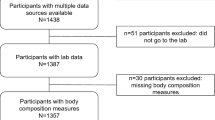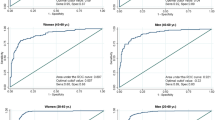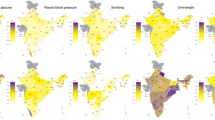Abstract
Objective:
To determine: (a) whether the components of metabolic syndrome (MetS) cluster more frequently than predicted by chance alone and (b) whether increased risk for MetS is associated also with values of each component below, but close to the cutoff points defining MetS.
Research design and methods:
Anthropometrical and biochemical measurements were performed and a dietary questionnaire was filled-in in 1833 randomly selected non-diabetic subjects, 916 men and 917 women, 20–74 years old, in nine centres in five Mediterranean countries. The prevalence of MetS and of possible combinations of its individual components was measured. The expected frequencies of the above combinations were calculated according to the mathematical formula of probabilities.
Results:
The overall prevalence of MetS was 27.2%, but varied greatly among countries, from 5.8% in Algeria to 37.3% in Greece. The observed prevalence of each combination diagnostic of MetS was higher than the expected by chance. Thus, the observed overall prevalence of MetS was also higher than the expected, 27.2 vs 24.0%, P=0.03. Furthermore, for each individual component (except high-density lipoprotein), as values in the normal range, approached the cutoff point, the risk of having MetS (i.e. clustering of the other components) increased significantly (odds ratio 2.2–4.6, P<0.001).
Conclusions:
The MetS is not related to the Mediterranean type of diet and its prevalence varies greatly among five Mediterranean countries. The clustering of the components defining the MetS is not due to chance and moreover even ‘high normal’ levels of each component confer increased risk for the syndrome.
This is a preview of subscription content, access via your institution
Access options
Subscribe to this journal
Receive 12 print issues and online access
$259.00 per year
only $21.58 per issue
Buy this article
- Purchase on Springer Link
- Instant access to full article PDF
Prices may be subject to local taxes which are calculated during checkout
Similar content being viewed by others
References
Alexander CM, Landsman PB, Teutsch SM, Haffner SM, Third National Health and Nutrition Examination Survey (NHANES III); National Cholesterol Education Program (NCEP) (2003). NCEP-defined metabolic syndrome, diabetes, and prevalence of coronary heart disease among NHANES III participants age 50 years and older. Diabetes 52, 1210–1214.
American Diabetes Association (2005). Diagnosis and classification of diabetes mellitus. Diabetes Care 28 (Suppl 1), S5–S10.
Armitage P (1983). The meaning of probability. In: Statistical Methods in Medical Research. Blackwell Scientific Publications: Oxford. ISBN 0 632 05430 1. pp. 44.–52.
Athyros VG, Ganotakis ES, Elisaf M, Mikhailidis DP (2005). The prevalence of the metabolic syndrome using the National Cholesterol Educational Program and International Diabetes Federation definitions. Curr Med Res Opin 21, 1157–1159.
Cameron A, Shaw J, Zimmet P (2004). The metabolic syndrome: prevalence in worldwide populations. Endocrinol Metab Clin North Am 33, 351–375.
Carnethon MR, Loria CM, Hill JO, Sidney S, Savage PJ, Liu K, Coronary Artery Risk Development in Young Adults Study (2004). Risk factors for the metabolic syndrome: the Coronary Artery Risk Development in Young Adults (CARDIA) study, 1985–2001. Diabetes Care 27, 2707–2715.
Eckel R, Grundy S, Zimmet P (2005). The metabolic syndrome. Lancet 365, 1415–1428.
Ford ES, Giles WH, Mokdad AH (2004). Increasing prevalence of the metabolic syndrome among US adults. Diabetes Care 27, 2444–2449.
Ford ES, Giles WH, Dietz WH (2002). Prevalence of the metabolic syndrome among US adults: findings from the third National Health and Nutrition Examination Survey. JAMA 287, 356–359.
Girman CJ, Rhodes T, Mercuri M, Pyorala K, Kjekshus J, Pedersen TR et al. (2004). The metabolic syndrome and risk of major coronary events in the Scandinavian simvastatin survival study (4S) and the air force/texas coronary atherosclerosis prevention study (AFCAPS/TexCAPS). Am J Cardiol 93, 136–141.
Golden S, Folsom A, Coresh J, Sharrett R, Szklo M, Brancati F (2002). Risk factor groupings related to insulin resistance and their synergistic effects on subclinical atherosclerosis. The atherosclerosis risk in communities' study. Diabetes 51, 3069–3076.
Groop L (2000). Genetics of the metabolic syndrome. Br J Nutr 83 (Suppl 1), S39–S48.
Grundy SM, Brewer Jr HB, Cleeman Jr JI, Smith SC, Lenfant C, American Heart Association; National Heart, Lung, and Blood Institute (2004). Definition of metabolic syndrome: Report of the National Heart, Lung, and Blood Institute/American Heart Association conference on scientific issues related to definition. Circulation 109, 433–438.
Grundy SM (2004). What is the contribution of obesity to the metabolic syndrome? Endocrinol Metab Clin North Am 33, 267–282.
Haffner SM, D' Agostino Jr R, Mykkanen L, Tracy R, Howard B, Rewers M et al. (1999). Insulin sensitivity in subjects with type 2 diabetes: relationship to cardiovascular risk factors. The insulin resistance atherosclerosis study. Diabetes Care 22, 562–568.
Haffner SM, Valdez RA, Hazuda HP, Mitchell BD, Morales PA, Stern MP (1992). Prospective analysis of the insulin resistance syndrome (Syndrome X). Diabetes 41, 715–722.
Haffner SM, D' Agostino R, Saad MF, Rewers M, Mykkanen L, Selby J et al. (1996). Increased insulin resistance and insulin secretion in nondiabetic African-Americans and Hispanics compared with non-Hispanic whites. The Insulin Resistance Atherosclerosis Study. Diabetes 45, 742–748.
Isomaa B, Almgren P, Tuomi T, Forsen B, Lahti K, Nissen M et al. (2001). Cardiovascular morbidity and mortality associated with the Metabolic Syndrome. Diabetes Care 24, 683–689.
Karamanos B (1996). Interim report of the nutrition study group of the Mediterranean group for the study of diabetes (MGSD). Medicographia 18 (Suppl 1), 38–40.
Karamanos B, Thanopoulou A, Angelico F, Assaad-Khalil S, Barbato A, Del ben M et al. (2002). Nutritional habits in the Mediterranean basin. The macronutrient composition of diet and its relation with the traditional Mediterranean diet. Multi-Center Study of the Mediterranean Group for the Study of Diabetes (MGSD). Eur J Clin Nutr 56, 983–991.
Klein B, Klein R, Lee K (2002). Components of the metabolic syndrome and risk of cardiovascular disease and diabetes in Beaver Dam. Diabetes Care 25, 1790–1794.
Kromhout D, Keys A, Aravanis C, Buzina R, Fidanza F, Giampaoli S (1989). Food consumption patterns in the 1960s in seven countries. Am J Clin Nutr 49, 889–894.
Kylin E (1923). Studies of the hypertension – hyperglycemia – hyperuricemia syndrome (Studien ueber das hypertonie – hyperglykamie – hyperurikamie syndrome). Zentralblatt fuer Innere Medizin 44, 105–127.
Lakka HM, Laaksonen DE, Lakka TA, Niskanen LK, Kumpusalo E, Tuomileto J et al. (2002). Themetabolic syndrome and total and cardiovascular disease mortality in middle-aged men. JAMA 288, 2709–2716.
Lee YJ, Tsai J (2002). ACE gene insertion/deletion polymorphism associated with 1998 world health organization definition of metabolic syndrome in Chinese type 2 diabetic patients. Diabetes Care 25, 1002–1008.
Malik S, Wong N, Franklin S, Kamath T, L'Italien G, Pio J et al. (2004). Impact of the metabolic syndrome on mortality from coronary heart disease, cardiovascular disease, and all causes in United States adults. Circulation 110, 1245–1250.
McNeill AM, Rosamond WD, Girman CJ, Golden SH, Schmidt MI, East HE et al. (2005). The metabolic syndrome and 11-year risk of incident cardiovascular disease in the Atherosclerosis Risk In Communities study. Diabetes Care 28, 385–390.
Meigs JB, D' Agostino Sr RB, Wilson PW, Cupples LA, Nathan DM, Singer DE (1997). Risk variable clustering in the insulin resistance syndrome. The Framingham Offspring Study. Diabetes 46, 1594–1600.
Mykkanen L, Kuusisto J, Pyorala K, Laakso M (1993). Cardiovascular disease risk factors as predictors of type 2 (non-insulin-dependent) diabetes mellitus in elderly subjects. Diabetologia 36, 553–559.
National Cholesterol Education Program (NCEP) Expert Panel on Detection, Evaluation and Treatment of High Blood Cholesterol in Adults (Adult Treatment Panel III) (2001). Executive summary of the third report of the National Cholesterol Education Program (NCEP) Expert Panel on Detection, Evaluation and Treatment of High Blood Cholesterol in Adults (Adult Treatment Panel III). JAMA 285, 2486–2497.
Olijhoek J, van der Graaf Y, Banga JD, Algra A, Rabelink T, Visseren F (2004). The metabolic syndrome is associated with advanced vascular damage in patients with coronary heart disease, stroke, peripheral arterial disease or abdominal aortic aneurism. Eur Heart J 25, 342–348.
Palaniappan L, Carnethon M, Wang Y, Hanley A, Fortmann S, Haffner S et al. (2004). Predictors of the incident Metabolic Syndrome in adults. Diabetes Care 27, 788–793.
Reaven GM (1988). Banting Lecture 1988: Role of insulin resistance in human disease. Diabetes 37, 1595–1607.
Schmidt MI, Watson RL, Duncan BB, Metcalf P, Brancati FL, Sharrett AR et al. (1996). Clustering of dyslipidemia, hyperuricemia, diabetes, and hypertension and its association with fasting insulin and central and overall obesity in a general population. Atherosclerosis Risk in Communities Study Investigators. Metabolism 45, 699–706.
Stern M, Williams K, Gonzalez-Villalpando C, Hunt K, Haffner S (2004). Does the metabolic syndrome improve identification of individuals at risk of type 2 diabetes and/or cardiovascular disease? Diabetes Care 27, 2676–2681.
Trichopoulou A, Costacou T, Bamia Ch, Trichopoulos D (2003). Adherence to a Mediterranean diet and survival in a Greek population. N Engl J Med 348, 2599–2608.
Trichopoulou A, Kouris-Blazos A, Wahlqvist M, Gnardellis Ch, Lagiou P, Polychronopoulos E et al. (1995). Diet and overall survival in elderly people. BMJ 311, 1457–1460.
Trichopoulou A, Orphanos Ph, Norat T, Bueno-de-Mesquita B, Ocki M, Peeters P et al. (2005). Modified Mediterranean diet and survival: EPIC-elderly prospective cohort study. BMJ 330, 991–998.
Wilson P, Kannel W, Silbershatz H, D' Agostino R (1999). Clustering of metabolic factors and coronary heart disease. Arch Intern Med 159, 1104–1109.
World Data Table http://who.org/cvd_atlas_29_world_data_table.pdf.
Acknowledgements
We thank all the subjects who took part in this study. The study is part of the MultiCentre Nutritional Study of the Mediterranean Group for the Study of Diabetes (MGSD). We thank Ms E Antoniadou and Ms M Panagiotopoulou for secretarial support and Ms P Maraki for laboratory assistance.
Author information
Authors and Affiliations
Corresponding author
Additional information
Guarantors: B Karamanos.
Contributors: AT and BK conducted the statistical analysis and wrote the intial draft. All authors participated in the design, interpretation and writing up of the research work.
Participating centres
Professor B Karamanos (Co-ordinator), A Thanopoulou, D Roussi
Diabetes Centre, 2nd Medical Department, Athens University Medical School, Hippokration Hospital, Athens, Greece
Professor F Angelico, M Del Ben, A Barbato
Department of Clinics and Applied Medical Therapy, University ‘La Sapienza’, Rome, Italy
Professor S Assaad Khalil
Department of Internal Medicine, Alexandria Faculty of Medicine, Alexandria, Egypt
Professor P Djordjevic, V Dimitrijevic-Sreckovic, F Canovic
Diabetes Centre, Institute for Endocrinology, Diabetes and Metabolic Diseases, Clinical Centre of Serbia, Belgrade, Yugoslavia.
Professor N Katsilambros
Diabetes Centre, 1st Department of Propedeutic Medicine, Athens University School of Medicine, Laiko General Hospital, Athens, Greece
Dr I Migdalis
Diabetes Centre, ‘ÍÉÌÔS’ Hospital, Athens, Greece
Dr M Mrabet, S Zarat, A Bentounsi
Service de Medicine Interne ‘A’ CHU Oran, Algeria
Dr M Petkova
Diabetes Centre ‘St Luca’, Sofia, Bulgaria
Professor MT Tenconi, C Gallotti
Dipartimento di Medicina Preventiva, Occupazionale e di Communita. Sezione di Igiene. Universita degli studi di Pavia, Italy
Rights and permissions
About this article
Cite this article
Thanopoulou, A., Karamanos, B., Angelico, F. et al. Epidemiological evidence for the non-random clustering of the components of the metabolic syndrome: multicentre study of the Mediterranean Group for the Study of Diabetes. Eur J Clin Nutr 60, 1376–1383 (2006). https://doi.org/10.1038/sj.ejcn.1602467
Received:
Revised:
Accepted:
Published:
Issue Date:
DOI: https://doi.org/10.1038/sj.ejcn.1602467
Keywords
This article is cited by
-
Reduced heart rate variability is related to the number of metabolic syndrome components and manifest diabetes in the sixth Tromsø study 2007–2008
Scientific Reports (2022)
-
Active commuting to and from university, obesity and metabolic syndrome among Colombian university students
BMC Public Health (2018)
-
Analysis of agreement among definitions of metabolic syndrome in nondiabetic Turkish adults: a methodological study
BMC Public Health (2007)



